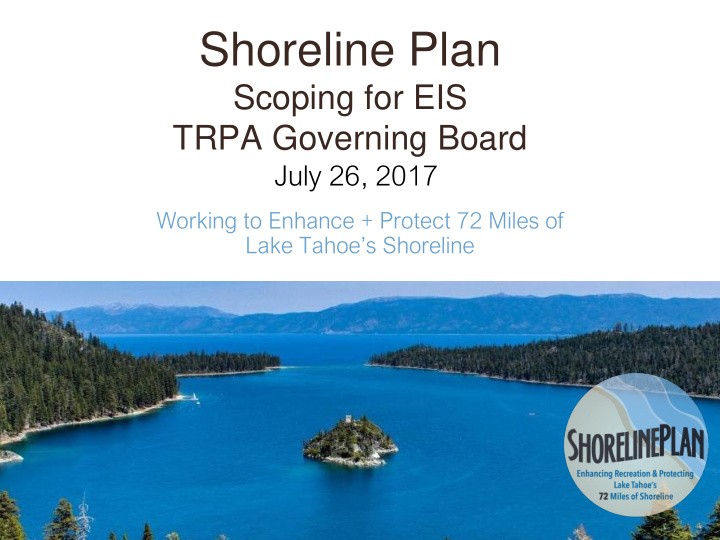



Shoreline Plan Scoping for EIS TRPA Governing Board July 26, 2017 Working to Enhance + Protect 72 Miles of Lake Tahoe’s Shoreline
EIS Scoping ➢ 30 Day Public Review- July 12-August 16 ➢ Feedback on scope and content of EIS
Scoping - Notice of Preparation ➢ Project Description ➢ Scope of EIS ➢ Possible Environmental Effects ➢ Alternatives
Scoping-Public Outreach Stakeholder Agencies and Organizations NV + CA State Clearinghouse Interested Public Media
Shoreline Planning Process Community Joint Fact Finding Committee Developing Shoreline CONSENSUS Steering Staff Committee Recommendations Community Policy Workshop Makers Series Input
Overarching Goal Enhance the recreational experience along Lake Tahoe’s shores while protecting the environment and responsibly planning for the future.
Organizing Principles Protect and Where Possible Enhance the Environment Fair and Reasonable System of Access Adapt to Changing Lake Levels Preserve Quality Recreation and Public Safety Implement Predictable and Consistent Rules
Protect and Enhance the Environment
Protect + Enhance Environment Use best available science Cap development potential Go slow Incentivize environmental improvements Avoid or mitigate impacts Allow scenic banking Adaptive Resource Management
Fair and Reasonable Access
Public Ramps Provide for new public boat ramps Geographically distributed near Sand Harbor Boat Ramp clustered development and transportation hubs
Marinas Promote Environmental Improvements Focus Capacity
MARINAS: Environmental Improvement Flow improvements, reducing Boat ramps for public use AIS habitat Access for fueling and pump-out Contribute to AIS controls stations lakewide Install stormwater BMPs beyond Cleaner rental fleets required Install electric charging stations Additional scenic improvement for boats Provide non-motorized boat Boater education storage for public Scenic improvements
Piers Provide sufficient new public piers Provide opportunity for private piers (including single- use) Incentivize multiple-use through permit prioritization + design standards Protect shoreline through quadrant + scenic sensitivity distribution
Buoys Cap total buoys on Lake Permitted buoys to remain Distribute new buoys among user types Limit new moorings (2 per littoral parcel)
Adapt to Low Lake Levels
Marinas + Ramps Additional row of buoy anchors Temporary pier + ramp extensions Limited dredging
HOAs Additional lakeward row of buoy anchors for buoy fields
Individual Littoral Parcels Additional lakeward buoy anchor for private littoral property owners Access deeper water with multiple use piers
Preserve Quality Recreation + Public Safety
Recreation Safety and Enforcement Maintain 600’ No Wake Zone + all of Emerald Bay Education on boater safety + no wake zone Coordinate shared enforcement - TRPA & States Remove unpermitted buoys Allow for Essential Public Health & Safety Facilities
Non-Motorized Boating Provide appropriate infrastructure Maintain No Wake Zone Education on boater safety Water Trail Program Limit pier length
Predictable and Consistent Rules
Predictable & Consistent Specific design standards for predictability, consistency and fairness Reduce complexity; provide greater certainty MOUs with States to clarify requirements and streamline permitting
Scoping: Possible Environmental Effects Water Quality Recreation Scenic Air Quality Fisheries Noise
Scoping: Potential Planning Alternatives “ Heart” of the EIS Focus on Possible Impacts from Proposed Plan Reasonable Range of Alternatives
Next Steps Public Meetings- Community Briefings Scoping Summary Report Develop Alternatives Draft EIS
Questions and Comments
Recommend
More recommend